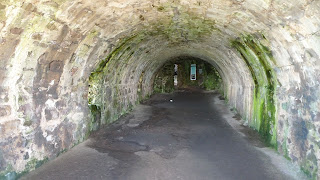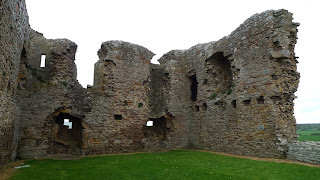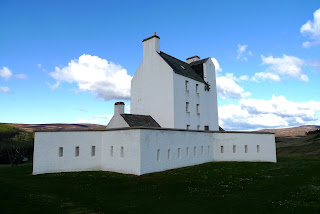Unlike England (brought under firm central control by 1500) or Wales (subdued and brought to heel even earlier), uprisings and general lawlessness continued in Scotland until the mid-1700s. It was necessary for a chieftain - and lesser mortals, also - to possess a stronghold that would resist attack, and function as a place of safety for his kinsfolk and faithful followers. Thus immensely strong castles were built, often taking advantage of the rugged terrain. Within the walls, the chieftain and his immediate family could live a civilised life, with fine stonework and plaster ceilings, and all the trappings of a cultivated gentleman - but always with an eye to the trustworthiness of his retinue, and the strength and reliability of his defences. And yet beneath the fine staterooms shoehorned into the thick walls would still be the dungeons vile, and flame-lit cells full of the gruesome instruments of torture.
I visited three castles on my Scottish Tour. The first was Dunnottar Castle, on the Aberdeenshire coast just south of Stonehaven. It's privately owned, and the entrance fee for me was £6. You pay just inside the castle. This is literally a cliff-top fortress, but built on a detached outlier - so it's even more secure and difficult to attack. To get to it, you must descend to the shore, then climb up again to the main gate, then climb further to the main part. Possibly that's all right if you have a pack horse. On foot, it's a bit fatiguing!
To be honest, you could simply admire the castle from the shore, or even from the adjacent cliffs, and still not miss anything essential. In this it's on par with Tintagel Castle in Cornwall - the drama of the whole scene is enough. But of course, I cheerfully paid the entrance fee, and saw it all.
Once up from the entrance, and onto the level part at the top, you are faced with a complex of stone buildings, nearly all in a ruinous condition. Some of them are partly subterranean, and seemingly older and cruder than the rest. But it's all evocative. You could easily imagine how it might be, on a winter's night, with the sea crashing against the rocks below, and a besieging army waiting for a chance on the surrounding cliffs. You'd feel safe from effective attack, to be sure; but still pretty cold and uncomfortable, if keeping watch in the biting wind.
The cliffs are formidable. I suppose the place could have been provisioned from the sea, but it would need a very calm day.
On the seaward side, there was a network of interconnecting basements or cellars:
In one long, sloping cellar Dunnottar's Big Crime was committed. In 1685, 167 men and women, all of them Covenanters - people unwilling to give alleigance to the English King and imprisoned for that (see https://en.wikipedia.org/wiki/Covenanter) - were kept here in this cellar, now known as the Whigs' Vault. Five died in the appalling conditions of their imprisonment, two more trying to escape, and many more on the voyage across the Atlantic, after the survivors were sentenced to transportation for their defiance and disloyalty. Imagine spending any time at all in this unsavoury and insanitary dungeon, in practically Black Hole of Calcutta conditions:
Another room commemorates something brighter - the saving of the Honours of Scotland, the Scottish Crown Jewels, which were kept safe here when The Lord Protector, Oliver Cromwell, ruled England after the beheading of Charles I.
Now my second castle, Duffus Castle, which is situated in farmland south-west of Lossiemouth on the Moray coast, and pretty well at the end of a busy RAF runway. Jet aircraft were taking off every few minutes when I was there.
This is another old castle, built with strong walls, but now ruinous. It's in the care of Historic Scotland, and there is no charge. I like free castles very much! I had it to myself, apart from some workmen engaged in repairing a section of wall. Although a ruin, it seemed impressive. I've paid good money elsewhere to see something very similar.
I had a free air show too. Back at the castle car park, it was very difficult to scoff the sandwiches I'd brought along for lunch. I kept on having to leap out of Fiona, in a largely unsuccessful attempt to photograph the planes. They seemed to whizz overhead very fast. These were my best results. If you are into aircraft, I dare say you'll know at once what I managed to shoot. I have no idea myself.
Finally my third castle, set in the heart of the Grampian Mountains, just off the A939 between Tomtintoul and Ballater. It's Corgarff Castle. I approached it from the north, along the desolate Lecht Road, which I imagine must be a nightmare of thick snow for two or three months of the year. The surrounding hills are almost empty - not a place to linger, even on a summer's afternoon. Here is a view of the Lecht Road, taken through Fiona's windscreen, with its snow poles; and a view of the mountains in the middle and far distances.
In the turbulent 1700s, these bare and apparently empty hills would be no barrier to a band of highland fighters intent on raiding. So the English Army built military roads, and here and there established a defensible strongpoint. Corgarff Castle was one of these: an existing tower house with a wide field of view, now strengthened by a star-shaped curtain wall with ports to fire muskets through. It was a lonely outpost. The first glimpse I got, as the A939 descended into a valley - the River Don, no less, one of the two rivers that flow out to sea at Aberdeen - revealed how completely Corgarff Castle was lost in the bigger scene. It's that tiny white thing in the centre of the next shot:
I looked forward to seeing something of the castle before it closed for the day, but I was too late by half an hour. It didn't seem to matter. One could still walk up the track, and view the exterior from all angles.
That star-shaped outer wall is rather fascinating, don't you think? To my mind, the whole building lends itself to an abstract composition, with the dreamy clouds playing a key role.
I didn't stay for very long. It was getting cold, I felt hungry, and it would take me an hour to get back to Huntly. I hoped that the soldiers barracked inside this little fort during the mid-1700s and later had plenty of hearty provisions - including firewood! This would have been a very exposed spot in the winter.















































